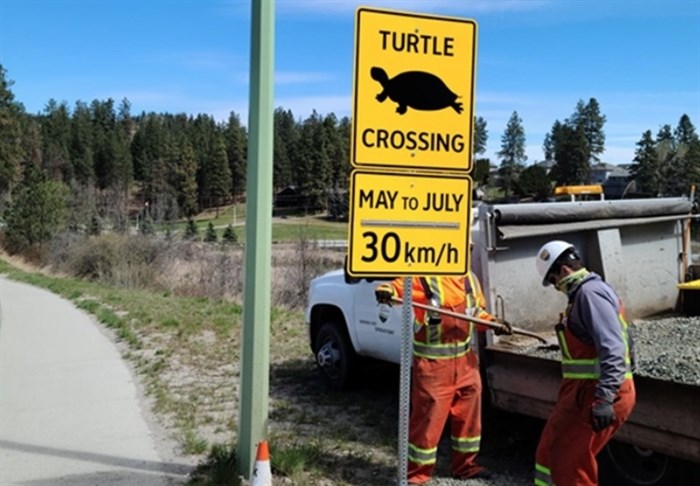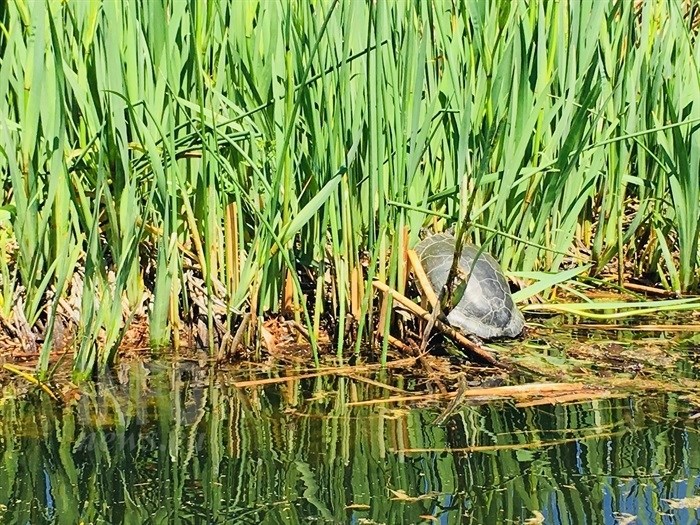
For many longtime Rose Valley residents, the turtles that migrate across Westlake Road on their way to breeding grounds mapped out in their DNA are a precious part of the community. But with a growing population in the farther reaches, the roadway became busier, more fast-moving and the creatures kept turning up on the busy road, smashed or injured.
Image Credit: FACEBOOK/City of West Kelowna
April 29, 2021 - 7:30 AM
For many longtime Rose Valley residents, the turtles that migrate across Westlake Road on their way to breeding grounds mapped out in their DNA are a precious part of the community.
But with a growing population in the farther reaches, the roadway became busier, more fast-moving and the creatures kept turning up on the busy road, smashed or injured.
“Last year we hired a biologist to do a bit of a study on the challenge with the turtles on Westlake Road and part of that study was installing video cameras to monitor behaviour,” Allen Fillion West Kelowna's director of engineering and public works said.
“The key thing that was learned is that they’re not using those tunnels.”
READ MORE: There is so much to know, and to love, about the Interior's endangered painted turtle
Fillion can’t say why exactly. There were coyotes and other species that had made good use of the tunnels and whether that had an effect on the turtles remains to be seen.
That information lent itself to recommendations to make the migratory path safer and more desirable for the turtles, with one of the chief priorities being upgrading fencing to direct the turtles to underground tunnels that had been built for them.
Then the consultant wrapped up with a report to look at more recommendations (for work to complete) this summer, Fillion said.
“We had funding approved now that will allow us to do more of this work. It will take a few weeks, some of it involves more fencing and some of it is on private property so there’s negotiations involved.”
They’ve also installed new signs that remind people that it’s a migratory route, and ask for motorists to slow down to 30/km an hour during peak turtle travel time. In case their speedometer isn’t upon to snuff, a speed reader trailer has been placed roadside as well.
READ MORE: Painted turtles get much needed extra attention in West Kelowna neighbourhood
“If we can get people to slow down then, they're big enough to see, you should be able to avoid them,” Fillion said.
“I can’t speak for RCMP resources but we did put a referral to them to add (the area) to speed watch.”
Ultimately, however, Fillion said that most of the traffic in the area is aware of the turtles and operates accordingly, these reminders will hopefully go some distance to filling in the rest.
According to the Ministry of Environment, the Painted Turtle requires wetlands, ponds or similar small bodies of water for hiding and foraging, adjacent to upland areas with dry, light-textured soils for nesting.
“Unfortunately, within its limited British Columbia range, the Painted Turtle is threatened by alteration or destruction of this important habitat,” the website said.

A painted turtle soaks up some rays in Kelowna.
(MARSHALL JONES / iNFOnews.ca)
“Wetlands and ponds are drained, filled and modified to meet human needs. Landowners can assist the continued survival of British Columbia's only native freshwater turtle by taking care to avoid disturbing turtles and protecting known breeding locations on their property.”
Of note, Up to ninety percent of all turtle nests are lost to predators; of those that make it out of the nest, only one in five will survive to adulthood.
If they do survive, Painted Turtles can live 20 to 30 years and grow to be the size of dinner plates. They are the most northerly occurring and most widespread turtles in North America, and young turtles hatch in the fall and endure winter temperatures well below freezing before they leave the nest in late spring or early summer.
Because turtle ribs form part of their shell, they are unable to breathe by expanding and contracting ribs; instead, they contract and relax their abdominal muscles to pump air in and out of their lungs. Turtles have no external ears but their shell conducts low-frequency vibrations to the middle ear.
To contact a reporter for this story, email Kathy Michaels or call 250-718-0428 or email the editor. You can also submit photos, videos or news tips to the newsroom and be entered to win a monthly prize draw.
We welcome your comments and opinions on our stories but play nice. We won't censor or delete comments unless they contain off-topic statements or links, unnecessary vulgarity, false facts, spam or obviously fake profiles. If you have any concerns about what you see in comments, email the editor in the link above.
News from © iNFOnews, 2021